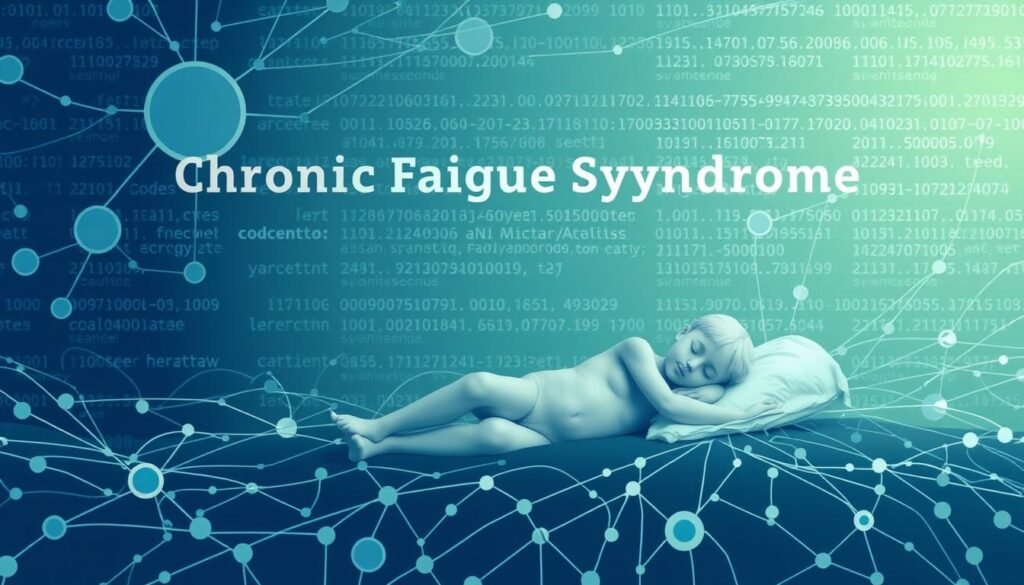It might surprise you, but around 3.3 million people in the U.S. have Myalgic Encephalomyelitis/Chronic Fatigue Syndrome (ME/CFS). Sadly, over 90% of them haven’t been diagnosed yet. This condition doesn’t just impact daily life; it also hits the economy hard. The U.S. loses between $18 billion and $51 billion every year because of it. This includes lost wages and healthcare costs. The ICD-10 code for chronic fatigue syndrome is crucial. It helps correctly identify and manage the illness, impacting patient care and financial matters.
For healthcare workers and patients alike, knowing the chronic fatigue syndrome diagnosis code is vital. This knowledge is the first step toward finding the right treatment and getting proper medical care. We’ll take a close look at what chronic fatigue syndrome is, the signs to watch for, and how accurate coding helps in treating ME/CFS. Interested in the specific ICD-10 code? It’s R53.82. Learn more about this condition at this link.
Key Takeaways
- Approximately 3.3 million people in the U.S. suffer from ME/CFS.
- Over 90% of those with ME/CFS have not received a formal diagnosis.
- ME/CFS costs the U.S. economy $18 billion to $51 billion each year.
- Accurate coding is crucial for treatment and reimbursement in ME/CFS.
- The ICD-10-CM code R53.82 is commonly used for unspecified chronic fatigue.
Understanding Chronic Fatigue Syndrome
Chronic fatigue syndrome (CFS) is a complex disorder. It features extreme fatigue lasting at least six months, not eased by rest. It can hinder daily activities and lessen quality of life. To grasp CFS, one should know its symptoms, diagnostic hurdles, and its commonness.
There’s no exact test for CFS diagnosis yet. A diagnosis typically involves a history of ongoing symptoms. These can encompass severe fatigue, rest that doesn’t refresh, and trouble thinking clearly. Often, patients deal with post-exertional malaise (PEM), experiencing worse symptoms after physical or mental effort, leading to tough recoveries.
A proper diagnosis requires a thorough health check, including exams of the body and nervous system, as well as lab tests. It’s crucial for medical records to accurately note CFS. This ensures correct billing and helps with getting treatment costs covered.
- Symptoms must persist for over six months for a CFS diagnosis.
- Thorough medical history and physical exams are essential for diagnosis.
- PEM is a common experience, worsening after exertion.
The latest ICD-10-CM code for CFS, G93.32, was introduced on October 1, 2022. It lets doctors record conditions precisely. This update aids in tracking ME/CFS cases better and helps with research and funding. Recognizing CFS’s significance is key to enhancing care and filling in diagnostic gaps.
What is the ICD-10 Code for Chronic Fatigue Syndrome?
The ICD-10 is key for diagnosing health issues, including chronic fatigue syndrome (CFS). The code for this condition is G93.32, which stands for myalgic encephalomyelitis/chronic fatigue syndrome. Since October 1, 2022, this code helps doctors properly document CFS cases. This is crucial for correct diagnosis, treatment plans, and insurance dealings.
Another code, R53.82, relates to unspecified chronic fatigue. This code hasn’t changed much and won’t until at least October 1, 2024. Using the right codes ensures patients are managed well and treatments are covered.
Doctors should look into the latest guidelines on the ICD-10 codes for better understanding.
Chronic fatigue syndrome causes severe tiredness lasting more than six months. People with it often feel muscle pain, have trouble thinking, and don’t sleep well. It mainly affects women in their 40s and 50s, seriously impacting work, school, and social life.
chronic fatigue syndrome icd 10
Chronic Fatigue Syndrome (CFS) falls under ICD-10 code G93.32. This includes Myalgic Encephalomyelitis. It shows the importance of knowing its definition and category. Before, CFS was marked by R53.82 (Chronic fatigue, unspecified). Now, G93.32 offers clearer diagnostic criteria. This helps doctors tell it apart from similar conditions.
Definition and Classification
CFS is known for its relentless or relapsing fatigue for at least six months. This fatigue greatly affects daily activities. Other symptoms are memory issues, pain, and sleep that doesn’t refresh, even with rest. Understanding CFS definition and classification helps us see how it affects lives. It mostly strikes people in their 40s and 50s, and women are more often diagnosed.
Comparison with Other Medical Conditions
CFS is sometimes confused with fibromyalgia and other chronic fatigue disorders. Below is a table with a chronic fatigue syndrome comparison. It outlines important similarities and differences.
| Condition | Common Symptoms | Duration of Symptoms | Restfulness |
|---|---|---|---|
| Chronic Fatigue Syndrome | Fatigue, memory impairment, pain, sore throat, tender lymph nodes | 6 months or more | Not significantly alleviated by rest |
| Fibromyalgia | Widespread pain, fatigue, sleep disturbances | Chronic, varies | Sometimes alleviated by rest |
| Postviral Fatigue Syndrome | Fatigue, muscle pain, sleep issues | Variable, often less than 6 months | May improve with rest |
This table helps with diagnosing and caring for chronic fatigue. It’s vital for doctors to properly classify CFS versus other conditions. This assures the right treatment plans are used. Knowing these details improves patient care and management.
Symptoms of Chronic Fatigue Syndrome
Chronic Fatigue Syndrome (CFS) comes with many symptoms that deeply affect people. Knowing these symptoms helps us recognize CFS and its big impact. Let’s explore the main symptoms and how they change routines and life quality.
Common Symptoms Experienced by Patients
Patients often face a wide range of symptoms in differing strengths and occurrences. Key CFS symptoms are:
- Profound fatigue: An extreme tiredness that rest doesn’t fix.
- Sleep disturbances: Problems like insomnia or not feeling refreshed after sleep.
- Cognitive difficulties: Issues with focus, memory, and processing information.
- Muscle pain: Unexplained soreness and pain in muscles.
- Post-exertional malaise (PEM): Intense fatigue after physical or mental activities.
- Orthostatic intolerance: Trouble standing up, causing dizziness or fainting.
These symptoms often majorly limit daily activities, affecting work, relationships, and personal life.
Impact on Daily Life and Activities
Chronic fatigue syndrome greatly challenges engaging in work, school, and social life. It’s reported that up to 75% struggle with jobs or daily chores.
About 25% of those diagnosed end up homebound or bedridden at times. Fluctuating symptoms make a stable routine almost impossible.
| Aspect | Impact |
|---|---|
| Employment | 75% report difficulties holding jobs |
| Social Interaction | Challenges in maintaining friendships |
| Family Life | Inability to participate in family activities |
| Education | Up to 75% unable to attend school |
| Physical Activity | Post-exertional malaise limits engagement |
Getting to know the scope of CFS symptoms reveals the everyday challenges of those with the condition. Raising awareness helps build support for those affected.
The Diagnostic Criteria for Chronic Fatigue Syndrome
Diagnosing chronic fatigue syndrome (CFS) needs a deep look into a patient’s medical history. Doctors check how long the symptoms have lasted, needing at least six months. They also rule out other diseases with similar symptoms. This detailed check helps confirm a CFS diagnosis.
Understanding the Diagnostic Process
To diagnose CFS, doctors follow specific criteria from health organizations like the CDC and NIH. These criteria help doctors correctly identify the syndrome. Key symptoms include:
- Post-exertional malaise (PEM)
- Unrefreshing sleep
- Significant cognitive impairment
- Muscle and joint pain
These symptoms show how much CFS can affect a person’s daily life. They highlight the need for careful evaluations in diagnosing and managing CFS.
Criteria Set by Medical Authorities
Medical authorities have set criteria for diagnosing CFS. These standards make healthcare providers review patient symptoms thoroughly. They check if symptoms have lasted more than six months and ensure no other conditions are causing them.
| Criteria | Description |
|---|---|
| Symptom Duration | Symptoms must persist for at least six months. |
| Post-exertional Malaise | Exacerbation of symptoms after physical or mental exertion. |
| Sleep Disturbance | Unrefreshing sleep despite adequate duration. |
| Cognitive Issues | Significant difficulties with memory, concentration, or focus. |
Chronic Fatigue Syndrome Diagnosis Code
Correct coding for chronic fatigue syndrome is crucial for patient care. It plays a key role in treatment and resource management in healthcare. This code helps in laying the foundation for proper care.
Importance of Accurate Coding
Accurate coding of CFS helps healthcare providers understand its unique aspects. This leads to treatments that meet the exact needs of sufferers. It also makes insurance claims smoother for everyone involved. Wrong codes can cause poor management and care for patients.
How It Influences Patient Care
Diagnosis codes affect how doctors manage CFS. They guide doctors in choosing the right treatment options. The code G93.32 is important for identifying how to best support patients.
It also helps in recognizing what worsens symptoms and improves team communication. With the right coding, the quality of life for patients can significantly improve.

ICD-10 Code for Chronic Fatigue Syndrome: R53.82 and G93.32
The way we classify chronic fatigue syndrome (CFS) has changed with new ICD-10 codes. The ICD-10 code for chronic fatigue syndrome R53.82 is used for general chronic fatigue. It’s only used when there’s not a more specific diagnosis available.
Starting October 1, 2023, we have clearer codes for chronic fatigue. The G93.32 CFS code now clearly lists myalgic encephalomyelitis/chronic fatigue syndrome (ME/CFS). It stresses the importance of correctly writing down symptoms. G93.31 is for fatigue that lasts over six months after being sick, and G93.39 for other kinds of post-infection fatigue.
It’s crucial to code conditions accurately to truly reflect what the patient is experiencing. Proper documentation helps ensure coding accuracy. This leads to better chances of getting the costs covered. Since fatigue can come from various conditions, sometimes more codes are needed. This ensures the patient gets the care they need.
With increasing awareness of ME/CFS, the new codes help us understand these conditions better. This understanding is a step toward more effective treatments and better support for patients.
Chronic Fatigue Syndrome Coding: An Overview
Getting chronic fatigue syndrome coding right is key in medical billing. Coders need to follow certain rules to track diagnosis and treatment correctly. An overview of chronic fatigue syndrome coding shows why understanding the latest codes is vital. It also points out how mistakes can affect care.
Key Considerations for Medical Coders
Coders should pay attention to some important things:
- Familiarity with ICD-10 Updates: Keep up with updates, including the new codes G93.31 and G93.39 that started on October 1, 2022.
- Understanding Diagnostic Criteria: Know that symptoms must last six months or more. Also, be clear on postviral fatigue syndrome classifications.
- Utilizing Specific Codes: Use G93.32 for myalgic encephalomyelitis/chronic fatigue syndrome where it fits. This helps avoid mistakes in coding.
- Avoiding the Use of Non-specific Codes: Use codes like R53.82 (Chronic fatigue, unspecified) only when needed. It helps keep coding errors low.
Common Coding Errors to Avoid
To improve documentation, coders need to know about common errors. These errors include:
- Incorrect Code Selection: Using old codes or not updating to the newest ICD-10 codes for CFS.
- Failure to Document Symptoms: Forgetting to note patient symptoms can lead to wrong codes and billing issues.
- Neglecting Comorbid Conditions: Overlooking other conditions can make care and billing more complex.
- Insufficient Knowledge on Exclusions: Not considering exclusions like neurasthenia can mess up diagnosis classification.

| Code | Description |
|---|---|
| G93.31 | Postviral fatigue syndrome |
| G93.32 | Myalgic encephalomyelitis/chronic fatigue syndrome |
| G93.39 | Other post infection and related fatigue syndromes |
| R53.82 | Chronic fatigue, unspecified |
| R53.83 | Fatigue NOS (not otherwise specified) |
By focusing on key areas and avoiding mistakes, coders can greatly improve their work. This boosts patient care overall.
Chronic Fatigue Syndrome ICD-10 Update
The coding for chronic fatigue syndrome (CFS) has seen changes with the newest ICD-10 updates. This shift impacts how healthcare providers handle documentation and patient care. It’s key for them to grasp these updates for the best management of CFS and helping patients get the right treatment and support.
Recent Changes in Coding Guidelines
In 2023, the ICD-10-CM update brought in new codes for chronic fatigue syndrome. Before, codes like R53.82 were used for CFS. Now, codes like G93.31 for Postviral fatigue syndrome and G93.32 for Myalgic encephalomyelitis/chronic fatigue syndrome improve specificity. The changes also cleared up the categorization of conditions related to CFS, making everything clearer.
Implications for Healthcare Providers
For healthcare providers, the updates in CFS coding are impactful. More precise coding yields better data, which helps in understanding and tracking CFS. This detail aids in offering patients more tailored treatments. Plus, clearer coding simplifies the reimbursement process, ensuring providers are fairly compensated. Ultimately, these improvements foster a more structured support network for people with CFS, enhancing patient care.
| Previous ICD-10 Code | New ICD-10 Codes | Focus of New Codes |
|---|---|---|
| R53.82 (Chronic fatigue, unspecified) | G93.31 (Postviral fatigue syndrome) | Specificity for post-viral conditions |
| G93.32 (Myalgic encephalomyelitis/chronic fatigue syndrome) | Recognition of ME/CFS as a distinct diagnosis | |
| G93.39 (Other post infection and related fatigue syndromes) | Broader classification of fatigue syndromes |
Understanding Myalgic Encephalomyelitis (ME) and CFS
Myalgic encephalomyelitis and chronic fatigue syndrome (CFS) are closely related. Both have common symptoms like extreme tiredness, brain fog, and poor sleep. This makes diagnosing and treating them tricky.
About 25% of those with ME/CFS can’t leave their homes or beds. And up to 75% are unable to work or go to school. This shows how serious ME and CFS are. They hurt people’s ability to live normally.
There’s been a lot of debate about ME and CFS. Are they the same or different? New codes were introduced in 2023 to help with this. For example, G93.32 is now used for these conditions.
This new coding helps doctors understand ME and CFS better. It also improves how they care for patients. Knowing more about ME and CFS is important for health workers. They can then offer better support.

Treatment Options for Chronic Fatigue Syndrome
Managing Chronic Fatigue Syndrome (CFS) means using different treatments. These are chosen based on what the person needs. The treatments include medicine, therapy, and changes in one’s daily life. They help people feel better and control their symptoms.
Medication and Therapies
For CFS, medicines and therapies focus on lessening symptoms like pain and troubles with sleep or mood. Some common medicines are:
| Medication Type | Examples | Primary Use |
|---|---|---|
| Analgesics | Acetaminophen, Ibuprofen | Pain relief |
| Antidepressants | SSRIs, SNRIs, TCAs | Aiding mood and sleep |
| Benzodiazepines | Diazepam, Lorazepam | Short-term anxiety and sleep issues |
Apart from medicine, Cognitive Behavioral Therapy (CBT) and Graded Exercise Therapy (GET) can help. CBT works on cognitive issues and GET helps increase physical activity slowly.
Lifestyle Changes and Support Strategies
Making changes in your lifestyle is key to handling CFS symptoms. Some important strategies are:
- Pacing: Finding a balance between rest and activity to avoid making symptoms worse.
- Nutrition: Eating well to support your body’s health.
- Mental Health Support: Getting help through counseling or groups to take care of emotional health.
Having a supportive environment matters a lot for those with CFS. Family and caregivers play a big role. They must understand the illness and help with strategies. To learn more about CFS, you can check out a comprehensive resource online.
Conclusion
Chronic fatigue syndrome (CFS) affects millions worldwide, showing its huge impact. The work by institutions like the Institute of Medicine has helped us better understand this illness. This conclusion on chronic fatigue syndrome points out how crucial accurate diagnosis and proper coding are, especially with new post-viral syndromes appearing.
Healthcare pros are now using new criteria from the CDC to diagnose CFS. This means they need to be more aware and learn more about the condition. It is important to not just know the symptoms but also to care for patients wisely and kindly. This ensures those struggling get the right support and treatment.
More research and talks among doctors will help deal better with CFS. Advocating for better coding and learning resources is key. Healthcare workers play a big role in improving the lives of those with CFS.